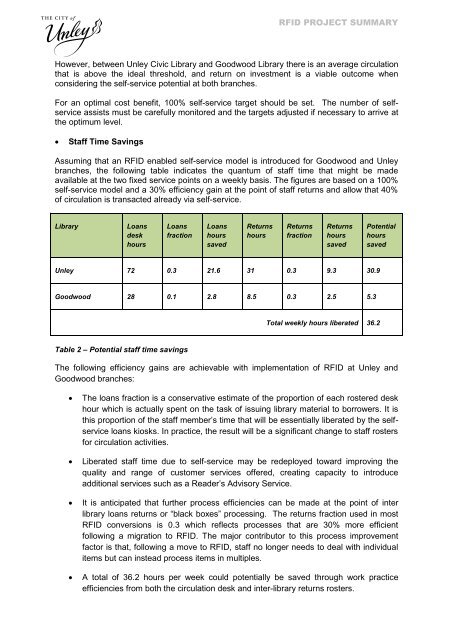RFID_Project_Summary
Create successful ePaper yourself
Turn your PDF publications into a flip-book with our unique Google optimized e-Paper software.
<strong>RFID</strong> PROJECT SUMMARY<br />
However, between Unley Civic Library and Goodwood Library there is an average circulation<br />
that is above the ideal threshold, and return on investment is a viable outcome when<br />
considering the self-service potential at both branches.<br />
For an optimal cost benefit, 100% self-service target should be set. The number of selfservice<br />
assists must be carefully monitored and the targets adjusted if necessary to arrive at<br />
the optimum level.<br />
<br />
Staff Time Savings<br />
Assuming that an <strong>RFID</strong> enabled self-service model is introduced for Goodwood and Unley<br />
branches, the following table indicates the quantum of staff time that might be made<br />
available at the two fixed service points on a weekly basis. The figures are based on a 100%<br />
self-service model and a 30% efficiency gain at the point of staff returns and allow that 40%<br />
of circulation is transacted already via self-service.<br />
Library<br />
Loans<br />
desk<br />
hours<br />
Loans<br />
fraction<br />
Loans<br />
hours<br />
saved<br />
Returns<br />
hours<br />
Returns<br />
fraction<br />
Returns<br />
hours<br />
saved<br />
Potential<br />
hours<br />
saved<br />
Unley 72 0.3 21.6 31 0.3 9.3 30.9<br />
Goodwood 28 0.1 2.8 8.5 0.3 2.5 5.3<br />
Total weekly hours liberated 36.2<br />
Table 2 – Potential staff time savings<br />
The following efficiency gains are achievable with implementation of <strong>RFID</strong> at Unley and<br />
Goodwood branches:<br />
<br />
<br />
<br />
<br />
The loans fraction is a conservative estimate of the proportion of each rostered desk<br />
hour which is actually spent on the task of issuing library material to borrowers. It is<br />
this proportion of the staff member’s time that will be essentially liberated by the selfservice<br />
loans kiosks. In practice, the result will be a significant change to staff rosters<br />
for circulation activities.<br />
Liberated staff time due to self-service may be redeployed toward improving the<br />
quality and range of customer services offered, creating capacity to introduce<br />
additional services such as a Reader’s Advisory Service.<br />
It is anticipated that further process efficiencies can be made at the point of inter<br />
library loans returns or “black boxes” processing. The returns fraction used in most<br />
<strong>RFID</strong> conversions is 0.3 which reflects processes that are 30% more efficient<br />
following a migration to <strong>RFID</strong>. The major contributor to this process improvement<br />
factor is that, following a move to <strong>RFID</strong>, staff no longer needs to deal with individual<br />
items but can instead process items in multiples.<br />
A total of 36.2 hours per week could potentially be saved through work practice<br />
efficiencies from both the circulation desk and inter-library returns rosters.



